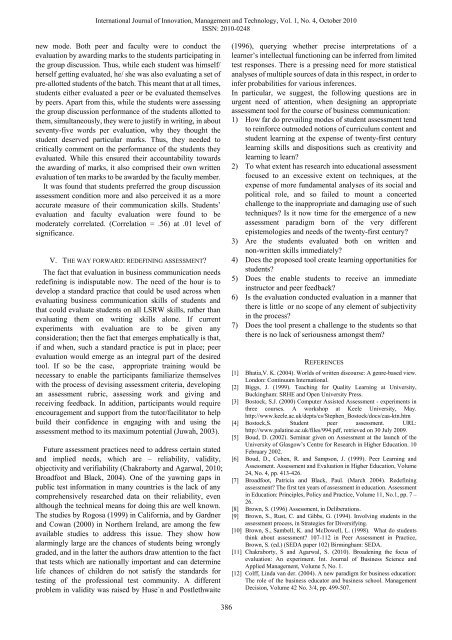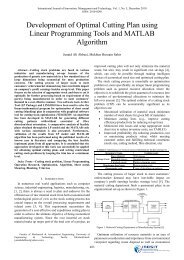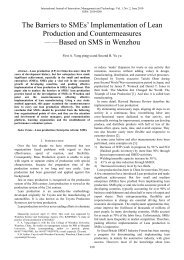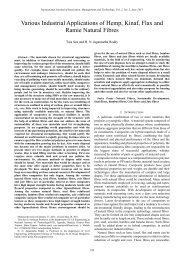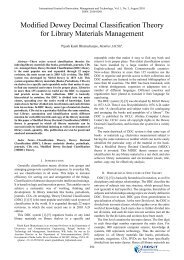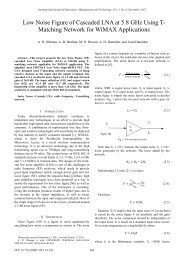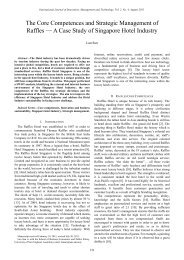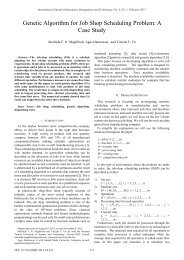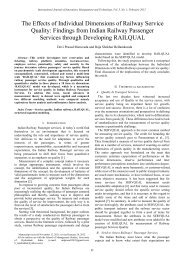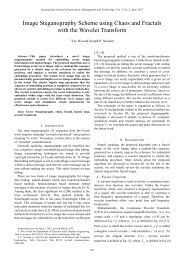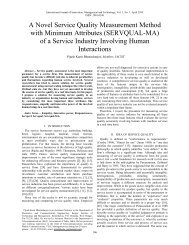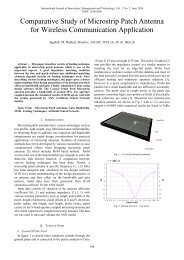Teaching and Evaluation of Business Communication ... - ijimt
Teaching and Evaluation of Business Communication ... - ijimt
Teaching and Evaluation of Business Communication ... - ijimt
Create successful ePaper yourself
Turn your PDF publications into a flip-book with our unique Google optimized e-Paper software.
International Journal <strong>of</strong> Innovation, Management <strong>and</strong> Technology, Vol. 1, No. 4, October 2010<br />
ISSN: 2010-0248<br />
new mode. Both peer <strong>and</strong> faculty were to conduct the<br />
evaluation by awarding marks to the students participating in<br />
the group discussion. Thus, while each student was himself/<br />
herself getting evaluated, he/ she was also evaluating a set <strong>of</strong><br />
pre-allotted students <strong>of</strong> the batch. This meant that at all times,<br />
students either evaluated a peer or be evaluated themselves<br />
by peers. Apart from this, while the students were assessing<br />
the group discussion performance <strong>of</strong> the students allotted to<br />
them, simultaneously, they were to justify in writing, in about<br />
seventy-five words per evaluation, why they thought the<br />
student deserved particular marks. Thus, they needed to<br />
critically comment on the performance <strong>of</strong> the students they<br />
evaluated. While this ensured their accountability towards<br />
the awarding <strong>of</strong> marks, it also comprised their own written<br />
evaluation <strong>of</strong> ten marks to be awarded by the faculty member.<br />
It was found that students preferred the group discussion<br />
assessment condition more <strong>and</strong> also perceived it as a more<br />
accurate measure <strong>of</strong> their communication skills. Students’<br />
evaluation <strong>and</strong> faculty evaluation were found to be<br />
moderately correlated. (Correlation = .56) at .01 level <strong>of</strong><br />
significance.<br />
V. THE WAY FORWARD: REDEFINING ASSESSMENT<br />
The fact that evaluation in business communication needs<br />
redefining is indisputable now. The need <strong>of</strong> the hour is to<br />
develop a st<strong>and</strong>ard practice that could be used across when<br />
evaluating business communication skills <strong>of</strong> students <strong>and</strong><br />
that could evaluate students on all LSRW skills, rather than<br />
evaluating them on writing skills alone. If current<br />
experiments with evaluation are to be given any<br />
consideration; then the fact that emerges emphatically is that,<br />
if <strong>and</strong> when, such a st<strong>and</strong>ard practice is put in place; peer<br />
evaluation would emerge as an integral part <strong>of</strong> the desired<br />
tool. If so be the case, appropriate training would be<br />
necessary to enable the participants familiarize themselves<br />
with the process <strong>of</strong> devising assessment criteria, developing<br />
an assessment rubric, assessing work <strong>and</strong> giving <strong>and</strong><br />
receiving feedback. In addition, participants would require<br />
encouragement <strong>and</strong> support from the tutor/facilitator to help<br />
build their confidence in engaging with <strong>and</strong> using the<br />
assessment method to its maximum potential (Juwah, 2003).<br />
Future assessment practices need to address certain stated<br />
<strong>and</strong> implied needs, which are – reliability, validity,<br />
objectivity <strong>and</strong> verifiability (Chakraborty <strong>and</strong> Agarwal, 2010;<br />
Broadfoot <strong>and</strong> Black, 2004). One <strong>of</strong> the yawning gaps in<br />
public test information in many countries is the lack <strong>of</strong> any<br />
comprehensively researched data on their reliability, even<br />
although the technical means for doing this are well known.<br />
The studies by Rogosa (1999) in California, <strong>and</strong> by Gardner<br />
<strong>and</strong> Cowan (2000) in Northern Irel<strong>and</strong>, are among the few<br />
available studies to address this issue. They show how<br />
alarmingly large are the chances <strong>of</strong> students being wrongly<br />
graded, <strong>and</strong> in the latter the authors draw attention to the fact<br />
that tests which are nationally important <strong>and</strong> can determine<br />
life chances <strong>of</strong> children do not satisfy the st<strong>and</strong>ards for<br />
testing <strong>of</strong> the pr<strong>of</strong>essional test community. A different<br />
problem in validity was raised by Huse´n <strong>and</strong> Postlethwaite<br />
(1996), querying whether precise interpretations <strong>of</strong> a<br />
learner’s intellectual functioning can be inferred from limited<br />
test responses. There is a pressing need for more statistical<br />
analyses <strong>of</strong> multiple sources <strong>of</strong> data in this respect, in order to<br />
infer probabilities for various inferences.<br />
In particular, we suggest, the following questions are in<br />
urgent need <strong>of</strong> attention, when designing an appropriate<br />
assessment tool for the course <strong>of</strong> business communication:<br />
1) How far do prevailing modes <strong>of</strong> student assessment tend<br />
to reinforce outmoded notions <strong>of</strong> curriculum content <strong>and</strong><br />
student learning at the expense <strong>of</strong> twenty-first century<br />
learning skills <strong>and</strong> dispositions such as creativity <strong>and</strong><br />
learning to learn<br />
2) To what extent has research into educational assessment<br />
focused to an excessive extent on techniques, at the<br />
expense <strong>of</strong> more fundamental analyses <strong>of</strong> its social <strong>and</strong><br />
political role, <strong>and</strong> so failed to mount a concerted<br />
challenge to the inappropriate <strong>and</strong> damaging use <strong>of</strong> such<br />
techniques Is it now time for the emergence <strong>of</strong> a new<br />
assessment paradigm born <strong>of</strong> the very different<br />
epistemologies <strong>and</strong> needs <strong>of</strong> the twenty-first century<br />
3) Are the students evaluated both on written <strong>and</strong><br />
non-written skills immediately<br />
4) Does the proposed tool create learning opportunities for<br />
students<br />
5) Does the enable students to receive an immediate<br />
instructor <strong>and</strong> peer feedback<br />
6) Is the evaluation conducted evaluation in a manner that<br />
there is little or no scope <strong>of</strong> any element <strong>of</strong> subjectivity<br />
in the process<br />
7) Does the tool present a challenge to the students so that<br />
there is no lack <strong>of</strong> seriousness amongst them<br />
REFERENCES<br />
[1] Bhatia,V. K. (2004). Worlds <strong>of</strong> written discourse: A genre-based view.<br />
London: Continuum International.<br />
[2] Biggs, J. (1999). <strong>Teaching</strong> for Quality Learning at University,<br />
Buckingham: SRHE <strong>and</strong> Open University Press.<br />
[3] Bostock, S.J. (2000) Computer Assisted Assessment - experiments in<br />
three courses. A workshop at Keele University, May.<br />
http://www.keele.ac.uk/depts/cs/Stephen_Bostock/docs/caa-ktn.htm<br />
[4] Bostock,S. Student peer assessment. URL:<br />
http://www.palatine.ac.uk/files/994.pdf, retrieved on 30 July 2009.<br />
[5] Boud, D. (2002). Seminar given on Assessment at the launch <strong>of</strong> the<br />
University <strong>of</strong> Glasgow’s Centre for Research in Higher Education. 10<br />
February 2002.<br />
[6] Boud, D., Cohen, R. <strong>and</strong> Sampson, J. (1999). Peer Learning <strong>and</strong><br />
Assessment. Assessment <strong>and</strong> <strong>Evaluation</strong> in Higher Education, Volume<br />
24, No. 4, pp. 413-426.<br />
[7] Broadfoot, Patricia <strong>and</strong> Black, Paul. (March 2004). Redefining<br />
assessment The first ten years <strong>of</strong> assessment in education. Assessment<br />
in Education: Principles, Policy <strong>and</strong> Practice, Volume 11, No.1, pp. 7 –<br />
26.<br />
[8] Brown, S. (1996) Assessment, in Deliberations.<br />
[9] Brown, S., Rust, C. <strong>and</strong> Gibbs, G. (1994). Involving students in the<br />
assessment process, in Strategies for Diversifying.<br />
[10] Brown, S., Sambell, K. <strong>and</strong> McDowell, L. (1998). What do students<br />
think about assessment 107-112 in Peer Assessment in Practice,<br />
Brown, S. (ed.) (SEDA paper 102) Birmingham: SEDA.<br />
[11] Chakraborty, S <strong>and</strong> Agarwal, S. (2010). Broadening the focus <strong>of</strong><br />
evaluation: An experiment. Int. Journal <strong>of</strong> <strong>Business</strong> Science <strong>and</strong><br />
Applied Management, Volume 5, No. 1.<br />
[12] Colff, Linda van der. (2004). A new paradigm for business education:<br />
The role <strong>of</strong> the business educator <strong>and</strong> business school. Management<br />
Decision, Volume 42 No. 3/4, pp. 499-507.<br />
386


